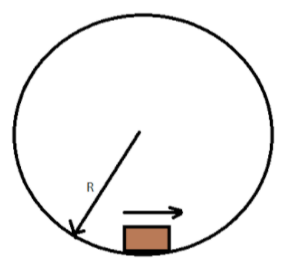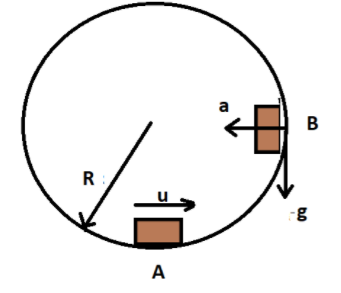Question
Question: A particle is given an initial speed \(u\) inside a smooth spherical shell of radius \(R = 1m\) such...
A particle is given an initial speed u inside a smooth spherical shell of radius R=1m such that it is just able to complete the circle. Acceleration of the particle when its velocity is vertical is:

A) g10
B) g
C) g2
D) g6
Solution
To solve this question, we have to calculate the resultant of the tangential and centripetal acceleration. We all know the value of tangential acceleration which is equal to the value of acceleration due to gravity. The centripetal acceleration can be calculated by using velocity and the radius of the circle.
Formulae used:
vl=5gl
Here vl is the velocity at the lowest point, g is the acceleration due to gravity and l is distance from center.
a=rv2
Here a is the centripetal acceleration, v is the tangential velocity at point B and r is the radius of the circle.
Complete step by step solution:
We know that in a circle the velocity at the lowest most position will be,
vl=5gl
Here vl is the velocity at the lowest point, g is the acceleration due to gravity and l is the distance.
So, u=5gl

Applying conservation of energy at points A and B, we get
⇒21mu2=21mv2+m(−)gl
Here u is the velocity at point A, v is the velocity at point B, m is the mass of the box, g is the acceleration due to gravity and l is the distance from the center.
The negative sign in gravity is because of its downwards action.
Simplifying the equation, we get,
⇒u2=v2−2gl
Putting the value of u, we get
⇒v2=(5gl)2−2gl
⇒v2=3gl
⇒v=3gl
So the value of tangential velocity at point B is 3gl.
We know that,
⇒a=rv2
Here a is the centripetal acceleration, v is the tangential velocity at point B and r is the radius of the circle.
Putting the values of v and r, we get
⇒a=3g

From the above diagram, the resultant acceleration acting on the body will be,
⇒anet=a2+g2+2agcos90∘
⇒anet=a2+g2
Putting the value of a=3g we get,
⇒anet=9g2+g2=g10
So the net acceleration acting on the body will be g10.
Hence option (A) is the correct option.
Note: In a vertical circle,
1. The velocity at the lower most position is v=5gl
2. The velocity at the horizontal position is v=3gl
3. The velocity at the top most position is v=gl
Here g is the acceleration due to gravity and l is the distance from the centre. Also for particles in a vertical circle, both centripetal acceleration and acceleration due to gravity acts on it.
